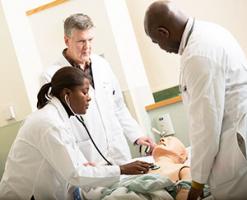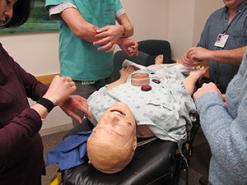Please click on each expandable section below to review the simulation orientation content. Completion will take less than 10 minutes, and will provide you with valuable information you need to know in order to participate in a simulation activity.
What is Simulation Education?
Simulation learning…
- Creates a realistic learning environment
- Immerses you in active experiential learning activities
- Puts you in the clinical space, caring for a patient
Simulation is utilized to…
- Learn a new skill
- Practice existing skills
- Assess competency
- Conduct research
- Test system response such as how a new piece of equipment will work in a clinical situation
Simulation must provide a…
- Psychologically safe environment
- Setting in which you are comfortable practicing (and possibly failing) skills in order to learn
- Confidential experience for you and your fellow learner where “what happens in Sim stays in Sim”
What do I need to know while I am in the Patient Safety Training Center (PSTC)?
- You should suspend your disbelief and immerse yourself in the training and treat the patient and the environment as a “real” clinical space with “real” patients
- Perform all the same safety procedures that you would in a real clinical environment such as:
- Washing your hands before and after patient contact
- Verifying patient identification
- Introducing yourself to the patient or family member
- Dress in your usual clinical attire and converse and practice professional behaviors as you would in a clinical setting
- Follow the Sim Center Ground Rules.
What helps create the clinical learning environment?
- Makeup called moulage to stage realistic-looking wounds
- Standardized patients who are trained to play the role of an ill patient
- Confederates are actors who play roles such as healthcare professionals and family members
- Manikins are human simulators that can:
- Produce vital signs that are displayed on the bedside monitor
- Blink and dilate
- Reproduce heart, lung, bowel sounds, and palpable pulses
- Have IVs, Foley catheters, and chest tubes placed
- Accommodate running of fluids and intubation
Reminders
- Please remember to sign-in
- The Sim Center is not a latex-free environment
- Dress in your typical clinical clothing
- Behave as if you were in an actual clinical environment
- Respect the confidentiality the Sim Center affords you and your peers to learn, make mistakes, and improve
- Take the opportunity to evaluate your learning experience at the end of each activity
- Food and drink are only allowed in the lobby, debrief rooms, and personal offices. They are not allowed in any other PSTC space.
Where is the Sim Center located?
The Sim Center – also known as The Patient Safety Training Center, or the Simulation-based Education and Research Center (SBER) – occupies 8,000 square feet on level two at Dartmouth Hitchcock Medical Center (DHMC).
Directions
From the Parking Garage:
You will enter DHMC on level 4. Take the East Mall elevators (on your left as you enter the building) down to level 2. Go straight ahead, and the entrance is at the end of the hallway.
From the Rotunda/Main Entrance:
Go straight past the main information desk through the Doctors’ Offices corridor. Take a right at the end (you are now in the East Mall). Go to the end of the mall and take the elevators on the right down to level 2. Go straight ahead, and the entrance is at the end of the hallway.

